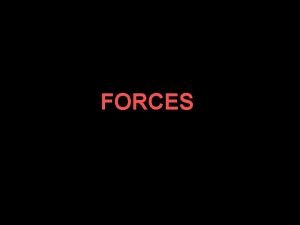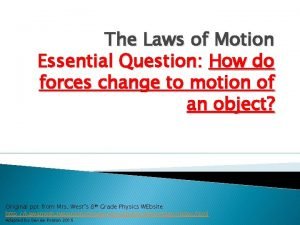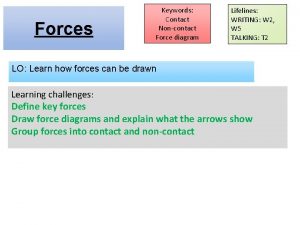Force and Motion Contact and noncontact forces Unit









- Slides: 9

Force and Motion Contact and non-contact forces Unit 1

Unit 2 Lesson 4 Types of Forces 3, 2, 1 Contact! What are some contact forces? • A contact force is a push or a pull on one object by another object that is touching it. • An applied force is a type of contact force in which one object directly pushes or pulls on another object. For example, in tug of war, you apply a pulling force to the rope. • A spring force (or elastic force) is the force exerted by a bending or stretching object on any object that is attached to it. Copyright © Houghton Mifflin Harcourt Publishing Company

Unit 2 Lesson 4 Types of Forces What are some contact forces? • Friction is the force an object exerts on an object that moves across it. The force of friction tends to oppose the motion of the object. • Air resistance is a type of contact force that air exerts on moving objects. Like friction, air resistance tends to oppose the motion of an object. Copyright © Houghton Mifflin Harcourt Publishing Company

Unit 2 Lesson 4 Types of Forces From a Distance What are some non-contact forces? • A force that pushes or pulls on an object without touching it is called a non-contact force. • A magnetic force is a non-contact force that exists between certain materials, such as magnetized iron. The force may be attractive (like a pull) or repulsive (like a push). Copyright © Houghton Mifflin Harcourt Publishing Company

Unit 2 Lesson 4 Types of Forces What are some non-contact forces? • An electrical force acts between objects that are electrically charged. It is a type of non-contact force. • Objects with like charges tend to repel (push) one another. Objects with unlike charges attract (pull) one another. • Gravitational force is a non-contact force of attraction that exists between any two objects that have mass. On Earth, we experience gravity as a downward force. Copyright © Houghton Mifflin Harcourt Publishing Company

Unit 2 Lesson 4 Types of Forces Down to Earth What are gravity’s effects? • Gravity accelerates objects. • All objects on Earth fall at the same rate once air resistance and other factors are removed. • Force = mass × acceleration due to gravity (F = mg). On Earth, g is about 9. 8 m/s 2. • All matter has mass, so all matter is affected by gravity. Copyright © Houghton Mifflin Harcourt Publishing Company

Unit 2 Lesson 4 Types of Forces What are gravity’s effects? • All objects experience gravitational attraction to all other objects. • Earth and other planets are round because of gravity. • Some objects in space are not round because they are too small for gravity to shape them into a sphere. • The paths of the planets, the sun, and our galaxy are determined by gravity. Copyright © Houghton Mifflin Harcourt Publishing Company

Unit 2 Lesson 4 Types of Forces A Weighty Issue What determines the force of gravity? • The law of universal gravitation states that all objects attract each other through gravitational force. • The strength of the gravitational force is related to the mass of the objects and the distance between them. Copyright © Houghton Mifflin Harcourt Publishing Company

Unit 2 Lesson 4 Types of Forces What determines the force of gravity? • Gravitational force between two objects increases as the distance between their centers decreases. • Gravitational force between two objects increases as their masses increases. Copyright © Houghton Mifflin Harcourt Publishing Company
 Force and motion
Force and motion Air resistance contact or non contact
Air resistance contact or non contact Is tension force contact or noncontact
Is tension force contact or noncontact Is air resistance a contact force
Is air resistance a contact force Is upthrust a contact or noncontact force
Is upthrust a contact or noncontact force Buoyancy force contact or noncontact
Buoyancy force contact or noncontact Air resistance contact force
Air resistance contact force Which is a contact force? *
Which is a contact force? * Contact and non contact force examples
Contact and non contact force examples Noncontact force examples
Noncontact force examples












